พฤติกรรมผู้นำเชิงยุทธศาสตร์
Main Article Content
บทคัดย่อ
การวิจัยเรื่องพฤติกรรมผู้นำเชิงยุทธศาสตร์ เป็นการวิจัยเชิงคุณภาพโดยสัมภาษณ์เชิงลึก ผู้ให้ข้อมูลสำคัญ จำนวน 12 คน ใช้วิธีการคัดเลือกแบบเจาะจง มีวัตถุประสงค์ (1) เพื่อศึกษาพฤติกรรมผู้นำเชิงยุทธศาสตร์ (2) เพื่อศึกษาปัญหาพฤติกรรมผู้นำเชิงยุทธศาสตร์ ทำการวิเคราะห์ข้อมูลโดยการวิเคราะห์เนื้อหาแบบสรุปความเชิงพรรณนา ผลการศึกษาสรุปได้ว่า พฤติกรรมผู้นำเชิงยุทธศาสตร์ด้านการบริหาร: เป็นผู้นำที่มีความสามารถในการนำพาประเทศ ดูแลจัดการบ้านเมืองดี แก้ไขปัญหาความสงบของบ้านเมืองได้ มีความซื่อสัตย์สุจริต พูดจริงทำจริง กล้าตัดสินใจ มีความมุ่งมั่นในการพัฒนาประเทศ พฤติกรรมผู้นำเชิงยุทธศาสตร์ด้านสื่อมวลชนและประชาสัมพันธ์: สามารถสื่อสารกับสื่อมวลชนได้ดี มีพฤติกรรมการแสดงออก ทั้งท่าทาง สีหน้า น้ำเสียง แบบตรงไปตรงมา พฤติกรรมผู้นำเชิงยุทธศาสตร์ด้านอิทธิพลเชิงอุดมการณ์: มีความเป็นผู้นำสูง มีความกล้าหาญ กล้าตัดสินใจ มีความเข้มแข็ง สื่อสารตรงไปตรงมา พูดเสียงดังฟังชัดมีความมั่นใจและมุ่งมั่นในการแก้ไขปัญหา ของประเทศ รับฟังปัญหาประชาชน มีความจงรักภักดีต่อชาติ ศาสนา พระมหากษัตริย์ พฤติกรรมผู้นำเชิงยุทธศาสตร์ด้านการคำนึงถึงความเป็นปัจเจกบุคคล: มีความรักต่อประชาชนและประเทศชาติอย่างแท้จริง เป็นผู้นำที่ติดดิน เข้าหาประชาชน และเป็นที่พึ่งของประชาชนได้ ปฏิบัติกับทุกคนโดยเท่าเทียมกันไม่เลือกปฏิบัติ พฤติกรรมผู้นำเชิงยุทธศาสตร์ด้านกระตุ้นให้เกิดการใช้ปัญญา: เป็นผู้นำที่มีวิสัยทัศน์กว้างไกล พฤติกรรมผู้นำเชิงยุทธศาสตร์ด้านการสร้างแรงบันดาลใจ: เป็นผู้สร้างแรงบันดาลใจในด้านเป็นคนมุ่งมั่น ตั้งใจจริง มีความเสียสละในการทำหน้าที่แก้ปัญหาบ้านเมือง เป็นที่พึ่งของประชาชน มีความรับผิดชอบ กล้าขอโทษในสิ่งที่ทำผิดพลาด จงรักภักดีต่อสถาบันพระมหากษัตริย์ รักชาติ รักแผ่นดิน ปกป้องผลประโยชน์ชาติ มองการณ์ไกล และดำเนินนโยบายและโครงการใหญ่ ให้กับประเทศ องค์ความรู้ที่ได้จากงานวิจัยนี้ ทำให้ทราบและสามารถนำไปใช้ให้เกิดประโยชน์คือ การเป็นผู้นำเชิงยุทธศาสตร์จะต้องเป็นผู้สร้างการแปลงเปลี่ยนไปในทางที่ดีและสร้างสรรค์ พร้อมทั้งรักษาความมั่นคงและทำให้องค์กรหรือหน่วยงานดำเนินงานไปได้ด้วยความราบรื่นและอย่างยั่งยืน อีกทั้งมีความสามารถที่ทำให้ผู้อื่นยอมรับการชี้นำที่ก่อให้เกิดความสำเร็จผลตามที่ต้องการ
Article Details
ทัศนะและความคิดเห็นที่ปรากฏในวารสาร ถือเป็นความรับผิดชอบของผู้เขียนบทความนั้น และไม่ถือเป็นทัศนะและความรับผิดชอบของกองบรรณาธิการ
เอกสารอ้างอิง
เชษินีร์ แสวงสุข. (2560). ภาวะผู้นำการเปลี่ยนแปลงของผู้บริหารสถานศึกษาที่ส่งผลต่อความพึงพอใจในการปฏิบัติงานของครู (ครุศาสตรมหาบัณฑิต สาขาวิชาการบริหารการศึกษา). มหาวิทยาลัยราชภัฏรำไพพรรณี.
เนตร์พัณณา ยาวิราช. (2552). ภาวะผู้นำและผู้นำเชิงกลยุทธ์. (พิมพ์ครั้งที่ 7). กรุงเทพฯ: ศูนย์หนังสือจุฬาลงกรณ์มหาวิทยาลัย.
ประกาศ เรื่องยุทธศาสตร์ชาติ พ.ศ. 2561- 2580. (2561, 13 ตุลาคม). ราชกิจจานุเบกษา. เล่ม 135 ตอนที่ 82 ก หน้า 1.
ประภาเพ็ญ สุวรรณ. (2537). พฤติกรรมศาสตร์: พฤติกรรมสุขภาพและสุขศึกษา. กรงเทพฯ: เจ้าพระยาการพิมพ์.
สุเทพ พงศ์ศรีวัฒน์. (2545). ภาวะผู้นำ: ทฤษฎีและปฏิบัติ. เชียงราย: คณะวิทยาการจัดการ, สถาบันราชภัฏเชียงราย.
Bass, B. M. (1998). Transformational Leadership: Industrial, Military and Educational Impact. Mahwah, N.J.: Lawrence Erlbaum Associates.
Wright Mills, C. (1956). The Power Elite. New York: Oxford University Press.
DuBrin, A. J. (2015). Leadership: Research Findings, Practice, and Skills. (8th ed.). Florence, United States: South-Western College Publishing.
Hersey, P., Blanchard, K. H., & Johnson, D. E. (1996). Management of Organizational Behavior: Utilizing Human Resources. (7th ed.). N.J.: Pearson Prentice Hall.
McFarland, D. E. (1979). Management Foundations and Practices. (5th ed). New York: Macmillan.
Robbins, S. P., & Judge, T. A. (2007). Organizational Behavior. (12th ed). Upper Saddle River, N.J.: Pearson Prentice Hall.


